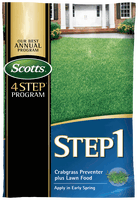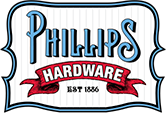Phillips Hardware Tips: Lawn Fertilizer
Phillips Hardware stores carry the exclusive Scotts Step Program. It is a wonderful tool for the DIY home owner that wants to create a lawn that leaves their neighbors envious. This program takes you through the whole process of early spring crabgrass preventer, late spring weed preventer, summer lawn food and fall lawn food for a better spring lawn. You can find rebates at your local hardware store for up to $50 back when you buy the complete Scotts Step Program.
 Scotts Step 1 – Crabgrass Preventer Plus Lawn Food 28-0-7
Scotts Step 1 – Crabgrass Preventer Plus Lawn Food 28-0-7
Step 1 feeds your lawn and prevents crabgrass plus other weeds from starting. Crabgrass spreads quickly during the warm summer months. Between midsummer and early fall, each plant produces thousands of seeds. The first frost kills the plants, but the seeds remain dormant through the winter. When the ground temperature warms up, the seeds begin to grow. New crabgrass appears from mid-spring to midsummer. You would apply it early in the spring after the snow has melted between February and April. You should not apply to newly seeded or sodded areas until after the 4th mowing.
Scotts Step 2 – Weed Control Plus Lawn Food 28-0-6
Step 2 also feeds your lawn and kills dandelions plus other weeds listed on the bag. You would apply it in late April through June to a wet lawn. After you apply it, you should wait at least 24 hours after that before watering the lawn. You should not apply to newly seeded or sodded areas until after the 4th mowing.
Scotts Step 3 – Lawn Food with 2% Iron 32-0-4
The iron in this Step feeds and strengthens lawns against heat and drought. You can apply it anytime from June to August to give your lawn a boost of green. It is guaranteed not to burn your lawn and is kid and pet friendly when used as directed so you can still have your backyard fun.
Scotts Step 4 – Fall Lawn Food 32-0-12
Apply this step in the fall to any grass type to help protect and strengthen for a better spring lawn. Apply it anytime from August through November and is also kid and pet friendly.
Know your Fertilizer Facts! The three numbers (often called NPK) on a fertilizer package tell you the percentage of the base elements nutrient makeup by weight. These numbers represent the percentage by weight of the three major nutrients required for healthy plant growth, always in the same order: nitrogen-phosphorus-potassium (N-P-K). Each of these nutrients affects plant growth differently, and the formulation you select should depend on your specific gardening needs.
The first number is the percentage of nitrogen (N) in the bag. Nitrogen provides plants with the ability to produce more chlorophyll, which in turn allows plants to grow quickly. With each additional nitrogen application, plants will grow taller and develop a darker green color. So if you want a dark green lawn, use a fertilizer that’s high in nitrogen – but then expect to mow more often.
The second number in the analysis is the percentage of phosphorus (P) in the mix. Phosphorous aids in root development and increases flowering ability and bloom size. Scotts Step program no longer has Phosphorus in its mix, as you can see by the 0 in the second number. Phosphorus encourages the blue-green algae bloom that area lakes experience each summer. Blue-green algae not only stinks but can be toxic to animals and children. When the algae bloom decays it reduces the oxygen in the water and can cause fish kills. Phosphorus run-off from feed lots, agricultural land and lawns is the main contributor to phosphorus in the lakes. Your lawn does not need Phosphorus unless you have a newly seeded lawn, most soil provides all the phosphorus your established lawn needs. If you are in doubt have your lawn tested before adding any phosphorus.
The third number represents the percentage of potassium (K) found in the product. A bag of 24-8-4 has 4 percent potassium in the mix. Potassium has many functions: It guards the plant against diseases and aids in drought protection and cold tolerance. It also serves a role in improving root development and helps in the process of photosynthesis. You might consider using a high-potassium fertilizer at the start of winter and summer to protect crops from temperature extremes or when insects and disease have caused damage to your plants.
The other percent remaining is usually inert filler material, such as clay pellets or granular limestone.
The best defense against crabgrass is a healthy lawn. Unwanted grasses and weeds simply can’t get the necessary toehold to thrive in a robust stand of grass. Follow these basic lawn care guidelines to keep crabgrass from becoming a problem in your yard: Mow at frequent intervals to keep the grass a fairly consistent length. Check the recommended mowing heights for your type of grass and cut your lawn at the highest recommended setting. Crabgrass requires plenty of light to germinate, so keep the grass as thick and long as possible to create shade near the soil surface. Cutting your lawn too close produces patches where crabgrass and other weeds can germinate.

